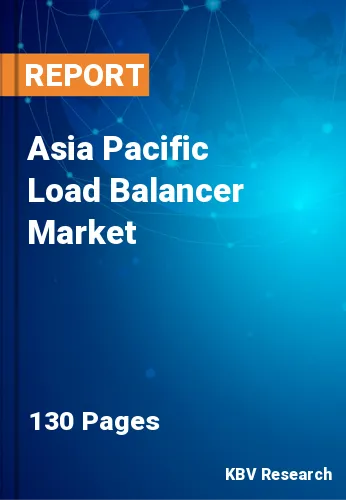The Asia Pacific Load Balancer Market would witness market growth of 14.9% CAGR during the forecast period (2022-2028).
The load balancer is crucial in regulating the traffic and directing it to the servers that can handle it efficiently without affecting the user experience. The load balancer is essential for monitoring the condition of servers, including web servers and backend servers. It directs traffic to the servers so they can effectively manage it.
To ensure that neither of the servers is overburdened, it, therefore, helps to boost speed and optimize server capacity. When a server is unavailable, the load balancer diverts traffic to other servers. The load balancer immediately starts forwarding requests to a new server when one is added.
The manner that the telecoms industry used to function has been completely transformed by load balancers. Wi-Fi, internet usage, and working from home are all proliferating trends that have prompted the telecommunications sector to build load balancing systems. These changes have increased the need for load balancing devices, which has helped the market grow.
The Chinese government is pushing the digital transformation of Chinese industries to levels that have never been seen before. Beijing also wants to make digital public services more accessible to everyone in order to improve the way the digital economy is governed. To do this, the Chinese government is putting more money into 6G research and development and encouraging innovation in key areas like integrated circuits and artificial intelligence (AI) (artificial intelligence). China's cloud service providers should put an emphasis on improving how technology works and making sure data is safe at the same time. Because the government helped traditional industries become more digital, more people started using the cloud. So, traditional businesses' use of cloud services is a key part of the future of the industry.
The China market dominated the Asia Pacific Load Balancer Market by Country 2021; thereby, achieving a market value of $974.9 million by 2028. The Japan market is registering a CAGR of 14.2% during (2022 - 2028). Additionally, The India market would showcase a CAGR of 15.7% during (2022 - 2028).
Based on Type, the market is segmented into Global Type and Local Type. Based on Component, the market is segmented into Hardware, Software, and Services. Based on End-use, the market is segmented into IT & Telecom, Manufacturing, Government & Defense, BFSI, Retail, Healthcare, and Others. Based on Enterprise Size, the market is segmented into Large Enterprises and Small & Medium Enterprises. Based on Deployment, the market is segmented into On-premise and Cloud. Based on countries, the market is segmented into China, Japan, India, South Korea, Singapore, Malaysia, and Rest of Asia Pacific.
Free Valuable Insights: The Worldwide Load Balancer Market is Projected to reach USD 11.8 Billion by 2028, at a CAGR of 14.4%
The market research report covers the analysis of key stake holders of the market. Key companies profiled in the report include A10 Networks, Inc., Amazon Web Services, Inc. (Amazon.com, Inc.), Citrix Systems, Inc, F5, Inc., Google LLC, Imperva, Inc., IBM Corporation, Progress Software Corporation (Kemp Technologies), Microsoft Corporation and Radware Ltd.
By Type
By Component
By End-use
By Enterprise Size
By Deployment
By Country
Our team of dedicated experts can provide you with attractive expansion opportunities for your business.

